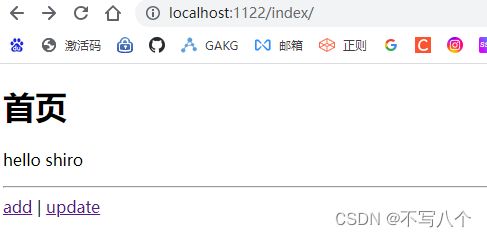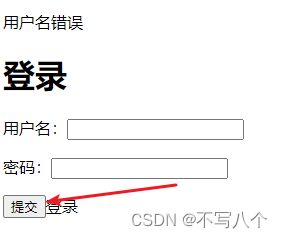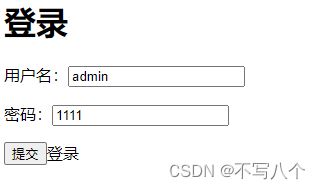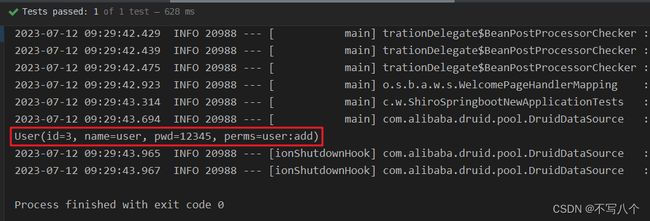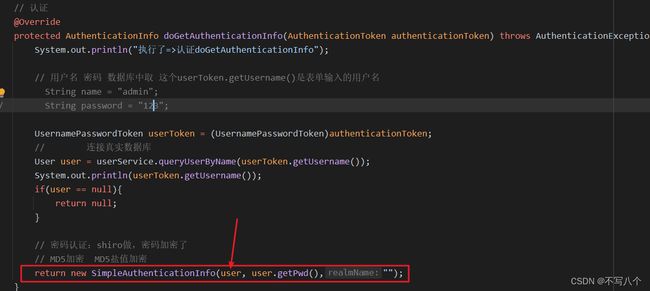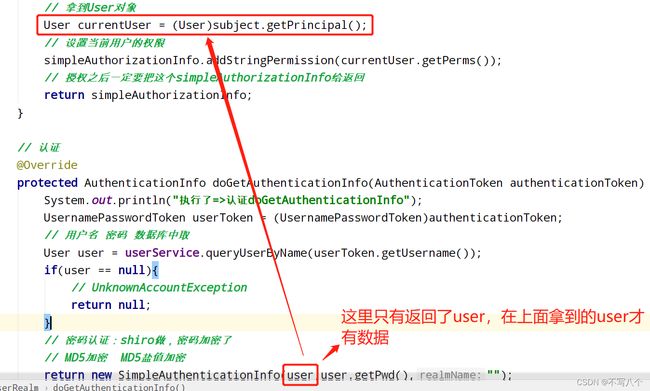Shiro教程(二):Springboot整合Shiro全网最全教程
Shiro教程(二):Springboot整合Shiro全网最全教程
1、SpringBoot整合Shiro环境搭建
新建
Module
新建springboot项目
选择一个依赖就行,因为这里idea版本的问题,SpringBoot的版本最低就是2.7.13。可以等项目创建成功之后,到
pom.xml中修改版本为2.5.6
添加
thymeleaf模版依赖
<dependencies>
<dependency>
<groupId>org.thymeleafgroupId>
<artifactId>thymeleaf-spring5artifactId>
dependency>
<dependency>
<groupId>org.thymeleaf.extrasgroupId>
<artifactId>thymeleaf-extras-java8timeartifactId>
dependency>
dependencies>
编写
index.html
在templates文件下创建index.html文件
DOCTYPE html>
<html lang="en" xmlns:th="http://www.thymeleaf.org"
xmlns:shiro="http://www.thymeleaf.org/thymeleaf-extras-shiro">
<head>
<meta charset="UTF-8">
<title>Titletitle>
head>
<body>
<h1>首页h1>
<p th:text="${msg}">p>
body>
html>
创建
com.wang.controller.MyController
package com.wang.controller;
import org.springframework.stereotype.Controller;
import org.springframework.ui.Model;
import org.springframework.web.bind.annotation.RequestMapping;
@Controller
public class MyController {
@RequestMapping({"/", "/index"})
public String toIndex(Model model){
model.addAttribute("msg", "hello shiro");
return "index";
}
}
启动程序,检查环境是否搭建成功
插曲:这里我设置启动程序的端口号为:1122
浏览器访问localhost:1122/index即可:
环境搭建成功。
接着整合shiro
1、导入依赖
<dependency>
<groupId>org.apache.shirogroupId>
<artifactId>shiro-springartifactId>
<version>1.10.0version>
dependency>
<dependency>
<groupId>org.apache.shirogroupId>
<artifactId>shiro-spring-boot-web-starterartifactId>
dependency>
2、初步配置
UserRealm类
package com.wang.config;
import org.apache.shiro.authc.AuthenticationException;
import org.apache.shiro.authc.AuthenticationInfo;
import org.apache.shiro.authc.AuthenticationToken;
import org.apache.shiro.authz.AuthorizationInfo;
import org.apache.shiro.realm.AuthorizingRealm;
import org.apache.shiro.subject.PrincipalCollection;
public class UserRealm extends AuthorizingRealm{
// 授权
@Override
protected AuthorizationInfo doGetAuthorizationInfo(PrincipalCollection principalCollection) {
System.out.println("执行了=>授权doGetAuthorizationInfo");
return null;
}
// 认证
@Override
protected AuthenticationInfo doGetAuthenticationInfo(AuthenticationToken authenticationToken) throws AuthenticationException {
System.out.println("执行了=>认证doGetAuthenticationInfo");
return null;
}
}
3、编写配置类
ShiroConfig
package com.wang.config;
import org.apache.shiro.spring.web.ShiroFilterFactoryBean;
import org.apache.shiro.web.mgt.DefaultWebSecurityManager;
import org.springframework.beans.factory.annotation.Qualifier;
import org.springframework.context.annotation.Bean;
import org.springframework.context.annotation.Configuration;
@Configuration
public class ShiroConfig {
// 3、ShiroFilterFactoryBean
@Bean("shiroFilterFactoryBean")
public ShiroFilterFactoryBean getShiroFilterFactoryBean(@Qualifier("securityManager") DefaultWebSecurityManager defaultWebSecurityManager){
ShiroFilterFactoryBean shiroFilterFactoryBean = new ShiroFilterFactoryBean();
// 设置安全管理器
shiroFilterFactoryBean.setSecurityManager(defaultWebSecurityManager);
return shiroFilterFactoryBean;
}
// 2、DefaultWebSecurityManager
@Bean(name = "securityManager")
public DefaultWebSecurityManager getDefaultWebSecurityManager(@Qualifier("userRealm")UserRealm userRealm){
DefaultWebSecurityManager securityManager = new DefaultWebSecurityManager();
// 关联UserRealm
securityManager.setRealm(userRealm);
return securityManager;
}
// 1、创建 realm对象 需要自定义
@Bean(name = "userRealm")
public UserRealm userRealm(){
return new UserRealm();
}
}
2、实现登录拦截
创建2个页面
add.html update.html
add.html
DOCTYPE html>
<html lang="en">
<head>
<meta charset="UTF-8">
<title>Titletitle>
head>
<body>
<h1>addh1>
body>
html>
update.html
DOCTYPE html>
<html lang="en">
<head>
<meta charset="UTF-8">
<title>Titletitle>
head>
<body>
<h1>updateh1>
body>
html>
有了页面,就去
controller添加跳转方法
package com.wang.controller;
import org.springframework.stereotype.Controller;
import org.springframework.ui.Model;
import org.springframework.web.bind.annotation.RequestMapping;
@Controller
public class MyController {
@RequestMapping({"/", "/index"})
public String toIndex(Model model){
model.addAttribute("msg", "hello shiro");
return "index";
}
@RequestMapping("/user/add")
public String add(){
return "user/add";
}
@RequestMapping("/user/update")
public String update(){
return "user/update";
}
}
给
index.html添加跳转连接
DOCTYPE html>
<html lang="en" xmlns:th="http://www.thymeleaf.org"
xmlns:shiro="http://www.thymeleaf.org/thymeleaf-extras-shiro">
<head>
<meta charset="UTF-8">
<title>Titletitle>
head>
<body>
<h1>首页h1>
<p th:text="${msg}">p>
<hr>
<a th:href="@{/user/add}">adda> |
<a th:href="@{/user/update}">updatea>
body>
html>
测试:重新启动程序
添加授权
@Bean("shiroFilterFactoryBean")
public ShiroFilterFactoryBean getShiroFilterFactoryBean(@Qualifier("securityManager") DefaultWebSecurityManager defaultWebSecurityManager){
ShiroFilterFactoryBean shiroFilterFactoryBean = new ShiroFilterFactoryBean();
// 设置安全管理器
shiroFilterFactoryBean.setSecurityManager(defaultWebSecurityManager);
// 添加shiro的内置过滤器
/*
anon:无需认证就可以访问
authc:必须认证才可以访问
user:必须有“记住我”功能才能使用
perms:拥有对某个资源的权限才能访问
role:拥有某个角色权限才能访问
*/
Map<String, String> filterChainDefinitionMap = new LinkedHashMap<>();
filterChainDefinitionMap.put("/user/add", "authc");
filterChainDefinitionMap.put("/user/update", "authc");
shiroFilterFactoryBean.setFilterChainDefinitionMap(filterChainDefinitionMap);
return shiroFilterFactoryBean;
}
再次启动程序访问,点击
add/update发现已经被拦截了
按道理应该跳转到登录页面,所以我们添加一个登陆页面:
DOCTYPE html>
<html lang="en">
<head>
<meta charset="UTF-8">
<title>Titletitle>
head>
<body>
<h1>登录h1>
<form action="">
<p>用户名:<input type="text" name="username">p>
<p>密码:<input type="text" name="password">p>
<p><input type="submit">登录p>
form>
body>
html>
接着在
controller添加登录页面的跳转
@RequestMapping("/toLogin")
public String toLogin(){
return "login";
}
然后在
ShiroConfig中添加登录的请求
@Bean("shiroFilterFactoryBean")
public ShiroFilterFactoryBean getShiroFilterFactoryBean(@Qualifier("securityManager") DefaultWebSecurityManager defaultWebSecurityManager){
ShiroFilterFactoryBean shiroFilterFactoryBean = new ShiroFilterFactoryBean();
// 设置安全管理器
shiroFilterFactoryBean.setSecurityManager(defaultWebSecurityManager);
// 添加shiro的内置过滤器
/*
anon:无需认证就可以访问
authc:必须认证才可以访问
user:必须有“记住我”功能才能使用
perms:拥有对某个资源的权限才能访问
role:拥有某个角色权限才能访问
*/
Map<String, String> filterChainDefinitionMap = new LinkedHashMap<>();
filterChainDefinitionMap.put("/user/add", "authc");
filterChainDefinitionMap.put("/user/update", "authc");
shiroFilterFactoryBean.setFilterChainDefinitionMap(filterChainDefinitionMap);
// 设置登录的请求
shiroFilterFactoryBean.setLoginUrl("/toLogin");
return shiroFilterFactoryBean;
}
再次重启程序点击
add/update,跳转到登录页面
3、实现用户认证
controller编写
@RequestMapping("/login")
public String login(String username, String password, Model model){
// 获取当前的用户
Subject subject = SecurityUtils.getSubject();
// 封装用户的登录数据
UsernamePasswordToken usernamePasswordToken = new UsernamePasswordToken(username, password);
// 执行登录的方法,如果没有异常就说明ok
try{
subject.login(usernamePasswordToken);
return "index";
}catch (UnknownAccountException e){
model.addAttribute("msg", "用户名错误");
return "login";
}catch (IncorrectCredentialsException e){
model.addAttribute("msg","密码错误");
return "login";
}
}
给login.html一个登录提示:
<p th:text="${msg}">p>
接着测试程序:点击提交之后弹出:
执行了=>认证doGetAuthenticationInfo
修改
UserRealm.java文件
// 认证
@Override
protected AuthenticationInfo doGetAuthenticationInfo(AuthenticationToken authenticationToken) throws AuthenticationException {
System.out.println("执行了=>认证doGetAuthenticationInfo");
// 用户名 密码 数据库中取 这个userToken.getUsername()是表单输入的用户名
String name = "admin";
String password = "123";
UsernamePasswordToken userToken = (UsernamePasswordToken)authenticationToken;
if(!userToken.getUsername().equals(name)){
return null;
}
// 密码认证:shiro做,密码加密了
// MD5加密 MD5盐值加密
return new SimpleAuthenticationInfo("",password,"");
}
正确的用户名密码是
admin 123
当输入错的密码的时候点击提交:
4、整合mybatis
导入相关依赖
<dependency>
<groupId>mysqlgroupId>
<artifactId>mysql-connector-javaartifactId>
dependency>
<dependency>
<groupId>log4jgroupId>
<artifactId>log4jartifactId>
<version>1.2.17version>
dependency>
<dependency>
<groupId>com.alibabagroupId>
<artifactId>druidartifactId>
<version>1.2.16version>
dependency>
<dependency>
<groupId>org.mybatis.spring.bootgroupId>
<artifactId>mybatis-spring-boot-starterartifactId>
<version>2.2.2version>
dependency>
<dependency>
<groupId>org.projectlombokgroupId>
<artifactId>lombokartifactId>
<version>1.18.26version>
dependency>
添加连接数据库配置文件
spring:
datasource:
password: 12345
username: root
url: jdbc:mysql://localhost:3306/shiro_db?useSSL=true&useUnicode=true&characterEncoding=UTF-8&serverTimezone=UTC
driver-class-name: com.mysql.cj.jdbc.Driver
type: com.alibaba.druid.pool.DruidDataSource
dbcp2:
initial-size: 5
min-idle: 5
max-wait-millis: 60000
time-between-eviction-runs-millis: 60000
min-evictable-idle-time-millis: 30000
validation-query: SELECT 1 FROM DUAL
test-while-idle: true
test-on-borrow: false
test-on-return: false
pool-prepared-statements: true
创建
pojo
package com.wang.pojo;
import lombok.AllArgsConstructor;
import lombok.Data;
import lombok.NoArgsConstructor;
/**
* @author Wang
* @date 2021/11/19 0019 20:43
* description
*/
@Data
@AllArgsConstructor
@NoArgsConstructor
public class User {
private int id;
private String name;
private String pwd;
private String perms;
}
创建
mapper
package com.wang.mapper;
import com.wang.pojo.User;
import org.apache.ibatis.annotations.Mapper;
import org.springframework.stereotype.Repository;
/**
* @author Wang
* @date 2021/11/19 0019 20:44
* description
*/
@Repository
@Mapper
public interface UserMapper {
User queryUserByName(String name);
}
创建
service和ServiceImpl
package com.wang.service;
import com.wang.pojo.User;
/**
* @author Wang
* @date 2021/11/19 0019 20:50
* description
*/
public interface UserService {
User queryUserByName(String name);
}
package com.wang.service;
import com.wang.mapper.UserMapper;
import com.wang.pojo.User;
import org.springframework.beans.factory.annotation.Autowired;
import org.springframework.stereotype.Service;
/**
* @author Wang
* @date 2021/11/19 0019 20:50
* description
*/
@Service
public class UserServiceImpl implements UserService {
@Autowired
UserMapper userMapper;
@Override
public User queryUserByName(String name) {
return userMapper.queryUserByName(name);
}
}
创建
mapper.xml
DOCTYPE mapper
PUBLIC "-//mybatis.org//DTD Mapper 3.0//EN"
"http://mybatis.org/dtd/mybatis-3-mapper.dtd">
<mapper namespace="com.wang.mapper.UserMapper">
<select id="queryUserByName" parameterType="String" resultType="com.wang.pojo.User">
SELECT * FROM mybatis.user where name = #{name}
select>
mapper>
写到这里别着急继续写,先测试一下刚刚写的业务是否正确,我们在ShiroSpringbootNewApplicationTests中添加测试代码:
package com.wang;
import com.wang.pojo.User;
import com.wang.service.UserService;
import org.junit.jupiter.api.Test;
import org.springframework.beans.factory.annotation.Autowired;
import org.springframework.boot.test.context.SpringBootTest;
@SpringBootTest
class ShiroSpringbootNewApplicationTests {
@Autowired
UserService userService;
@Test
void contextLoads() {
User user = userService.queryUserByName("user");
System.out.println(user);
}
}
运行查看结果:代码没有问题
接着去改造
UserRealm,去连接真实数据库:
// 认证
@Override
protected AuthenticationInfo doGetAuthenticationInfo(AuthenticationToken authenticationToken) throws AuthenticationException {
System.out.println("执行了=>认证doGetAuthenticationInfo");
// 用户名 密码 数据库中取 这个userToken.getUsername()是表单输入的用户名
// String name = "admin";
// String password = "123";
UsernamePasswordToken userToken = (UsernamePasswordToken)authenticationToken;
// 连接真实数据库
User user = userService.queryUserByName(userToken.getUsername());
System.out.println(userToken.getUsername());
if(user == null){
return null;
}
// 密码认证:shiro做,密码加密了
// MD5加密 MD5盐值加密
return new SimpleAuthenticationInfo("",user.getPwd(),"");
}
5、Shiro请求授权实现
先给数据库的user对象增加一个权限perms列
给pojo中的User对象也要加入perms属性
@Data
@AllArgsConstructor
@NoArgsConstructor
public class User {
private int id;
private String name;
private String pwd;
private String perms;
}
添加权限:用户需要有[user:add]才能访问user/add
filterChainDefinitionMap.put("/user/add", "perms[user:add]");
重启试一下:访问 /user/add,报错,说明授权成功
我们设置未授权跳转到为授权页面:
MyController中添加跳转
@RequestMapping("/noauth")
@ResponseBody
public String unauthorized(){
return "未经授权无法访问此页面";
}
在ShiroConfig中配置未授权页面跳转:
// 未授权页面
shiroFilterFactoryBean.setUnauthorizedUrl("/noauth");
再次访问/user/add效果如下:
我们可以在UserRealm中给来的用户添加权限:
SimpleAuthorizationInfo simpleAuthorizationInfo = new SimpleAuthorizationInfo();
simpleAuthorizationInfo.addStringPermission("user:add");
这样用户就能访问需要授权的接口/user/add了:
但是,这样有一个问题,不管是什么用户,都会进行授权,那接口的拦截就无意义了。
所以应该拿到当前的用户,并设置当前用户的权限,在UserRealm中添加代码
// 授权
@Override
protected AuthorizationInfo doGetAuthorizationInfo(PrincipalCollection principalCollection) {
System.out.println("执行了=>授权doGetAuthorizationInfo");
SimpleAuthorizationInfo simpleAuthorizationInfo = new SimpleAuthorizationInfo();
// 拿到当前登录的这个对象
Subject subject = SecurityUtils.getSubject();
// 拿到User对象
User currentUser = (User)subject.getPrincipal();
// 设置当前用户的权限
// simpleAuthorizationInfo.addStringPermission("user:add");
simpleAuthorizationInfo.addStringPermission(currentUser.getPerms());
return simpleAuthorizationInfo;
}
这里我们要修改认证的代码返回值,把user返回
return new SimpleAuthenticationInfo(user,user.getPwd(),"");
我们进行不同用户的测试:
使用user登录即可访问/user/add
6、整合Thymeleaf
先导入依赖包
<dependency>
<groupId>com.github.theborakompanionigroupId>
<artifactId>thymeleaf-extras-shiroartifactId>
<version>2.0.0version>
dependency>
写一个方法整合shiro-thymeleaf,在
ShiroConfig中添加以下代码
//整合ShiroDialect:用来整合shiro-thymeleaf
@Bean
public ShiroDialect getShiroDialect(){
return new ShiroDialect();
}
然后在首页判断用户是否有此权限
<div shiro:hasPermission="user:add">
<a th:href="@{/user/add}">adda>
div>
<div shiro:hasPermission="user:update">
<a th:href="@{/user/update}">updatea>
div>
我们继续使用user用户登录,该用户只有user:add权限:可以看到用户user登录只能看到add的功能:
使用root用户登录,该用户只有user:update权限:
我们登录之后,登录按钮不应该再显示了,我们在UserRealm中把用户信息加入session:
// 认证
@Override
protected AuthenticationInfo doGetAuthenticationInfo(AuthenticationToken authenticationToken) throws AuthenticationException {
System.out.println("执行了=>认证doGetAuthenticationInfo");
// 用户名 密码 数据库中取 这个userToken.getUsername()是表单输入的用户名
// String name = "admin";
// String password = "123";
UsernamePasswordToken userToken = (UsernamePasswordToken)authenticationToken;
// 连接真实数据库
User user = userService.queryUserByName(userToken.getUsername());
System.out.println(userToken.getUsername());
if(user == null){
return null;
}
Subject currentSubject = SecurityUtils.getSubject();
Session session = currentSubject.getSession();
session.setAttribute("loginUser",user);
// 密码认证:shiro做,密码加密了
// MD5加密 MD5盐值加密
return new SimpleAuthenticationInfo(user, user.getPwd(),"");
}
然后在前端判断,是否有user:
<div th:if="${session.loginUser==null}">
<a th:href="@{/toLogin}">登录a>
div>
再次登录,登录按钮不显示
7、完整代码下载地址
SpringBoot整合Shiro完整代码下载地址
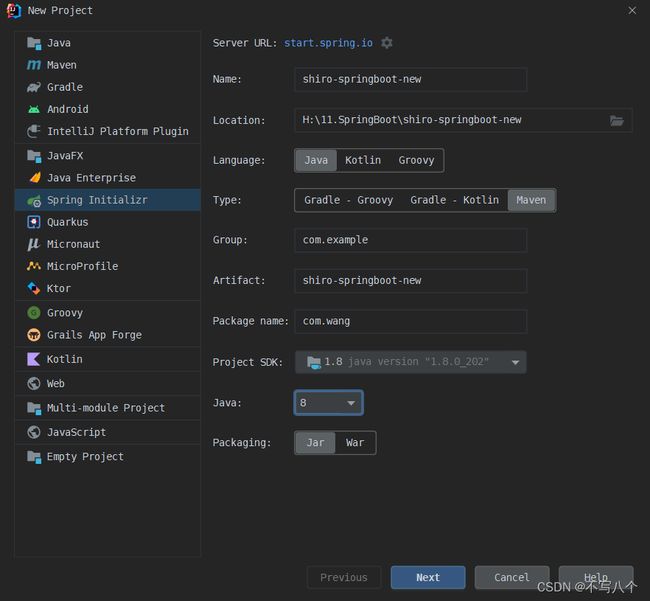




![[外链图片转存失败,源站可能有防盗链机制,建议将图片保存下来直接上传(img-5qAJ0kFA-1689132653268)(C:\Users\Administrator\AppData\Roaming\Typora\typora-user-images\image-20230711214429297.png)]](http://img.e-com-net.com/image/info8/bdb0986832a14b4391ad029308858f85.jpg)
